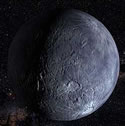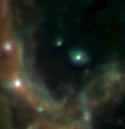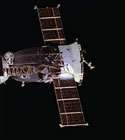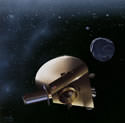
Image credit: Hubble
Astronomers have discovered a new object far past the orbit of Pluto. Dubbed Quaoar, the object is 1,200 km across (approximately 1/10th the size of the Earth), and orbits the sun once every 288 years. Although the object is half the size of the Pluto, it probably won’t be considered a new planet ? even Pluto’s planetness is hotly debated. Ironically, Quaoar was caught in images taken as far back as 20 years ago; astronomers just didn’t realize what they were looking at.
NASA’s Hubble Space Telescope has measured the largest object discovered in the solar system since the discovery of Pluto 72 years ago.
Approximately half the size of Pluto, the icy world 2002 LM60, dubbed “Quaoar” (pronounced kwa-whar) by its discoverers, is the farthest object in the solar system ever to be resolved by a telescope. It was initially detected by a ground-based telescope, as simply a dot of light, until astronomers aimed the powerful Hubble telescope at it.
Quaoar is about 4 billion miles away from Earth, well over a billion miles farther away than Pluto. Unlike Pluto, its orbit around the Sun is very circular, even more so than most of the planetary-class bodies in the solar system.
Although smaller than Pluto, Quaoar is greater in volume than all the asteroids combined (though probably only one-third the mass of the asteroid belt, because it’s icy rather than rocky). Quaoar’s composition is theorized to be largely ices mixed with rock, not unlike that of a comet, though 100 million times greater in volume.
This finding yields important new insights into the origin and dynamics of the planets, and the mysterious population of bodies dwelling in the solar system’s final frontier: the elusive, icy Kuiper belt beyond Neptune.
Michael Brown and Chadwick Trujillo of Caltech are reporting the findings today at the 34th annual meeting of the Division for Planetary Sciences of the American Astronomical Society in Birmingham, Ala.
Earlier this year, Trujillo and Brown used the Palomar Oschin Schmidt telescope to discover Quaoar as an 18.5-magnitude object creeping across the summer constellation Ophiuchus (it’s less than 1/10,000th the brightness of the faintest star seen by the human eye). Brown had to do follow-up observations using Hubble’s new Advanced Camera for Surveys on July 5 and August 1, 2002, to measure the object’s true angular size of 40 milliarcseconds, corresponding to a diameter of about 800 miles (1300 kilometers). Only Hubble has the sharpness needed to actually resolve the disk of the distant world, leading to the first-ever direct measurement of the true size of a Kuiper belt object (KBO).
Like Pluto, Quaoar dwells in the Kuiper belt, an icy debris field of comet-like bodies extending 7 billion miles beyond Neptune’s orbit. Over the past decade more than 500 icy worlds have been found in the Kuiper belt. With a few exceptions all have been significantly smaller than Pluto.
Previous record holders are a KBO called Varuna, and an object called 2002 AW197, each approximately 540 miles across (900 kilometers). Unlike Hubble’s direct observations, these diameters are deduced from measuring the objects’ temperatures and calculating a size based on assumptions about the KBOs’ reflectivity, so the uncertainty in true size is much greater.
This latest large KBO is too new to have been officially named by the International Astronomical Union. Trujillo and Brown have proposed naming it after a creation god of the Tongva native American tribe, the original inhabitants of the Los Angeles basin. According to legend, Quaoar, “came down from heaven; and, after reducing chaos to order, laid out the world on the back of seven giants. He then created the lower animals, and then mankind.”
Quaoar’s “icy dwarf” cousin, Pluto, was discovered in 1930 in the course of a 15-year search for trans-Neptunian planets. It wasn’t realized until much later that Pluto actually was the largest of the known Kuiper belt objects. The Kuiper belt wasn’t theorized until 1950, after comet orbits provided telltale evidence of a vast nesting ground for comets just beyond Neptune. The first recognized Kuiper belt objects were not discovered until the early 1990s. This new object is by far the “biggest fish” astronomers have snagged in KBO surveys. Brown predicts that within a few years even larger KBOs will be found, and Hubble will be invaluable for follow-up observations to pin down sizes.
Original Source: Hubble News Release
What is the biggest telescope in the world?



